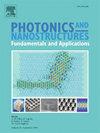超高频天线表面粗糙度综合分析
IF 2.5
3区 物理与天体物理
Q3 MATERIALS SCIENCE, MULTIDISCIPLINARY
Photonics and Nanostructures-Fundamentals and Applications
Pub Date : 2025-02-01
DOI:10.1016/j.photonics.2024.101345
引用次数: 0
摘要
适用于6 G应用的天线可能在w波段(75-110 GHz)工作,这需要很高的制造精度,特别是精细的表面加工。这种具有良好表面的天线可以使用许多不同的技术来生产,例如化学蚀刻,铣削和增材制造。然而,即使是精细制造也会导致天线表面的某些缺陷,从而导致天线的性能下降。因此,数值和实验结果之间可能出现不希望出现的差异。为了研究这种影响,我们在多个适用于6 G应用的传统电磁设备中进行了表面粗糙度的电磁模拟。作为正在研究的天线,我们选择了喇叭天线和贴片天线。此外,我们还考虑了矩形WR-10波导和50欧姆微带传输线。表面粗糙度被实现为一组半球,这些半球在天线表面随机分布、增加或减少。在进行了一组模拟之后,我们评估了s参数、天线效率和指向性模式。然后将结果与具有理想表面的参考器件进行比较,以找出天线制造的最佳表面要求。本文章由计算机程序翻译,如有差异,请以英文原文为准。
Comprehensive analysis of surface roughness for extremely high frequency antennas
Antennas suitable for 6 G applications can potentially operate in the W-band (75–110 GHz), which requires fine manufacturing accuracy, particularly for fine surface processing. Such antennas with fine surfaces can be produced using many different techniques, such as chemical etching, milling, and additive manufacturing. However, even fine manufacturing leads to certain imperfections on the antenna surface that lead to the performance degradation of an antenna. As a result, an undesirable difference between the numerical and experimental results can occur. To study this effect, we performed electromagnetic simulations of surface roughness in multiple conventional electromagnetic devices suitable for 6 G applications. As antennas under investigation, we have chosen a horn antenna and a patch antenna. In addition, we consider a rectangular WR-10 waveguide and a 50 Ohm microstrip transmission line. Surface roughness has been implemented as a set of hemispheres, which are randomly distributed, added, or subtracted on the surface of the antenna. After performing a set of simulations, we evaluated the S-parameters, antenna efficiency, and directivity patterns. The results are then compared with reference devices with ideal surfaces to find the optimal surface requirement for antenna manufacturing.
求助全文
通过发布文献求助,成功后即可免费获取论文全文。
去求助
来源期刊
CiteScore
5.00
自引率
3.70%
发文量
77
审稿时长
62 days
期刊介绍:
This journal establishes a dedicated channel for physicists, material scientists, chemists, engineers and computer scientists who are interested in photonics and nanostructures, and especially in research related to photonic crystals, photonic band gaps and metamaterials. The Journal sheds light on the latest developments in this growing field of science that will see the emergence of faster telecommunications and ultimately computers that use light instead of electrons to connect components.

 求助内容:
求助内容: 应助结果提醒方式:
应助结果提醒方式:


